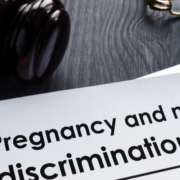New Protections for Pregnant and Postpartum Workers Are Now in Effect
By Brandee McGee
On Tuesday, June 27, the Pregnant Workers Fairness Act (PWFA) goes into effect after passing through Congress and being signed by President Biden last December. This landmark legislation, which offers federal protections to pregnant and postpartum workers, is one significant step in catching up with our peer countries when it comes to our treatment of pregnant people — and comes after a decade of advocacy by The Leadership Conference on Civil and Human Rights coalition with the support of advocates across the country.
The United States still ranks last in terms of maternal mortality rate compared to all other industrialized nations, and it is also the only major country to not offer any guaranteed paid maternity leave. While it’s easy to be disheartened, a look through each generation’s improvements demonstrates how far we’ve actually come over the last 50 years.
Federal protections for pregnant workers are less than 45 years old and began with the Pregnancy Discrimination Act (PRA) of 1978, which amended Title VII of the Civil Rights Act of 1964 to include pregnant people — shielding them against discriminatory actions like “firing, demotion, refusal to hire, or forced leave because of pregnancy or related conditions.”
My maternal grandmother was fired during two of her four pregnancies in the 1950s and 60s simply for being pregnant prior to enactment of the PRA. To make matters worse, birth control pills were not widely available for married women until after the Griswold decision in 1965, and abortion was not legalized until 1973. Like many women, my grandmother was also in an unstable marriage, which compromised her and her children’s financial stability. Because women could not practicably open their own bank account or get a credit card until 1974, when the Equal Credit Opportunity Act passed, pregnant women were completely reliant on their partners or families.
By the time my own mother was in her 20s, pregnant workers’ rights had expanded somewhat under the Americans with Disabilities Act of 1990 and the Family and Medical Leave Act of 1993. My mom could not legally be fired for being pregnant and had the legal ability to maintain financial independence in her marriage, even as she endured domestic violence by her partner. Unlike her mother before her, my mom’s right to work throughout her pregnancy was protected; however, she was still pressured to perform tasks as a dental assistant that she feared could negatively impact her pregnancy, was compelled to work up through all 40 weeks of her pregnancy to maintain financial security, and was not given any paid maternity leave — so she was right back at work within a month of giving birth both times.
The need to further expand pregnant worker protections became evident in 2015: Although the Supreme Court ruled against UPS in Young v. UPS after the company placed a pregnant worker on leave without pay when her doctor restricted the amount of weight she could lift, the Court maintained that workers were still only entitled to reasonable accommodations compared to similar workers and that an employee must make a showing “that the employer’s policies impose a ‘significant burden’ on pregnant workers, and that the employer has not raised a ‘sufficiently strong’ reason to justify that burden.” This is a massive burden for a plaintiff to overcome, and it has continued to disproportionately impact low-income workers.
In 2018, my sister was the very first in her maternal line to have a stable, salaried job when she became pregnant. The privilege she had as a worker in this high position granted her paid maternity leave, supplemental paid time off, and an unusually accommodating employer. As each generation of mothers ideally improves their financial position, so has federal legislation continued to improve protections for pregnant workers. Under the PWFA, “employers must now grant reasonable accommodations to pregnant people no matter how they treat ‘similar’ workers, so long as doing so would not impose an ‘undue hardship.’” Thanks to these expanded protections, my sister’s daughter will now enjoy even more rights — regardless of the type of work she does — if she becomes pregnant in the future.
There is still much work left for Congress to do to protect pregnant workers, including passing guaranteed paid parental leave (regardless of gender), taking steps to significantly improve maternal health outcomes, ensuring access to reproductive care, and more. But the PWFA’s expanded protections will inform how pregnant workers are safeguarded against discrimination and maternal poverty — no matter what state they reside in.







Leave a Reply
Want to join the discussion?Feel free to contribute!